Anthony Chen
Critical Foreign Policy Decisions (CFPD)-Benchmark: Measuring Diplomatic Preferences in Large Language Models
Mar 08, 2025Abstract:As national security institutions increasingly integrate Artificial Intelligence (AI) into decision-making and content generation processes, understanding the inherent biases of large language models (LLMs) is crucial. This study presents a novel benchmark designed to evaluate the biases and preferences of seven prominent foundation models-Llama 3.1 8B Instruct, Llama 3.1 70B Instruct, GPT-4o, Gemini 1.5 Pro-002, Mixtral 8x22B, Claude 3.5 Sonnet, and Qwen2 72B-in the context of international relations (IR). We designed a bias discovery study around core topics in IR using 400-expert crafted scenarios to analyze results from our selected models. These scenarios focused on four topical domains including: military escalation, military and humanitarian intervention, cooperative behavior in the international system, and alliance dynamics. Our analysis reveals noteworthy variation among model recommendations based on scenarios designed for the four tested domains. Particularly, Qwen2 72B, Gemini 1.5 Pro-002 and Llama 3.1 8B Instruct models offered significantly more escalatory recommendations than Claude 3.5 Sonnet and GPT-4o models. All models exhibit some degree of country-specific biases, often recommending less escalatory and interventionist actions for China and Russia compared to the United States and the United Kingdom. These findings highlight the necessity for controlled deployment of LLMs in high-stakes environments, emphasizing the need for domain-specific evaluations and model fine-tuning to align with institutional objectives.
Training-free Regional Prompting for Diffusion Transformers
Nov 04, 2024Abstract:Diffusion models have demonstrated excellent capabilities in text-to-image generation. Their semantic understanding (i.e., prompt following) ability has also been greatly improved with large language models (e.g., T5, Llama). However, existing models cannot perfectly handle long and complex text prompts, especially when the text prompts contain various objects with numerous attributes and interrelated spatial relationships. While many regional prompting methods have been proposed for UNet-based models (SD1.5, SDXL), but there are still no implementations based on the recent Diffusion Transformer (DiT) architecture, such as SD3 and FLUX.1.In this report, we propose and implement regional prompting for FLUX.1 based on attention manipulation, which enables DiT with fined-grained compositional text-to-image generation capability in a training-free manner. Code is available at https://github.com/antonioo-c/Regional-Prompting-FLUX.
EVA: An Embodied World Model for Future Video Anticipation
Oct 20, 2024



Abstract:World models integrate raw data from various modalities, such as images and language to simulate comprehensive interactions in the world, thereby displaying crucial roles in fields like mixed reality and robotics. Yet, applying the world model for accurate video prediction is quite challenging due to the complex and dynamic intentions of the various scenes in practice. In this paper, inspired by the human rethinking process, we decompose the complex video prediction into four meta-tasks that enable the world model to handle this issue in a more fine-grained manner. Alongside these tasks, we introduce a new benchmark named Embodied Video Anticipation Benchmark (EVA-Bench) to provide a well-rounded evaluation. EVA-Bench focused on evaluating the video prediction ability of human and robot actions, presenting significant challenges for both the language model and the generation model. Targeting embodied video prediction, we propose the Embodied Video Anticipator (EVA), a unified framework aiming at video understanding and generation. EVA integrates a video generation model with a visual language model, effectively combining reasoning capabilities with high-quality generation. Moreover, to enhance the generalization of our framework, we tailor-designed a multi-stage pretraining paradigm that adaptatively ensembles LoRA to produce high-fidelity results. Extensive experiments on EVA-Bench highlight the potential of EVA to significantly improve performance in embodied scenes, paving the way for large-scale pre-trained models in real-world prediction tasks.
Can Long-Context Language Models Subsume Retrieval, RAG, SQL, and More?
Jun 19, 2024


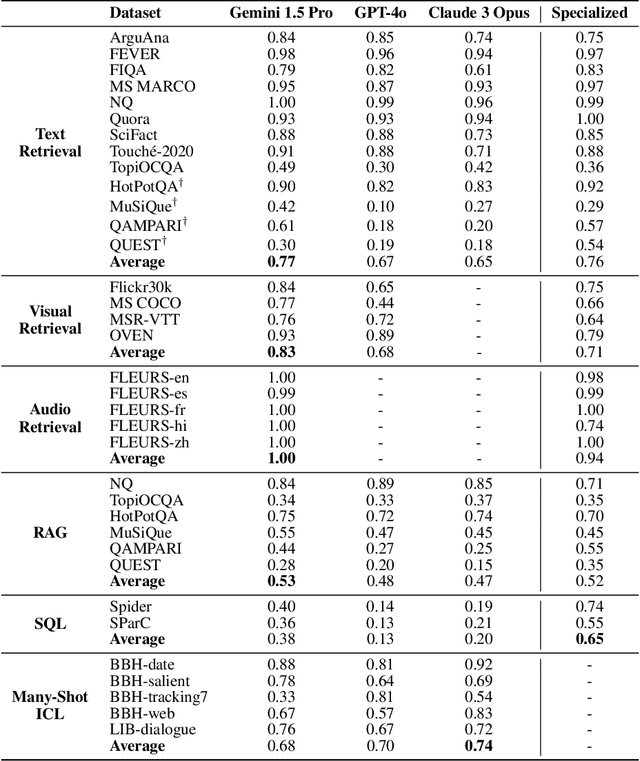
Abstract:Long-context language models (LCLMs) have the potential to revolutionize our approach to tasks traditionally reliant on external tools like retrieval systems or databases. Leveraging LCLMs' ability to natively ingest and process entire corpora of information offers numerous advantages. It enhances user-friendliness by eliminating the need for specialized knowledge of tools, provides robust end-to-end modeling that minimizes cascading errors in complex pipelines, and allows for the application of sophisticated prompting techniques across the entire system. To assess this paradigm shift, we introduce LOFT, a benchmark of real-world tasks requiring context up to millions of tokens designed to evaluate LCLMs' performance on in-context retrieval and reasoning. Our findings reveal LCLMs' surprising ability to rival state-of-the-art retrieval and RAG systems, despite never having been explicitly trained for these tasks. However, LCLMs still face challenges in areas like compositional reasoning that are required in SQL-like tasks. Notably, prompting strategies significantly influence performance, emphasizing the need for continued research as context lengths grow. Overall, LOFT provides a rigorous testing ground for LCLMs, showcasing their potential to supplant existing paradigms and tackle novel tasks as model capabilities scale.
InstantStyle: Free Lunch towards Style-Preserving in Text-to-Image Generation
Apr 04, 2024Abstract:Tuning-free diffusion-based models have demonstrated significant potential in the realm of image personalization and customization. However, despite this notable progress, current models continue to grapple with several complex challenges in producing style-consistent image generation. Firstly, the concept of style is inherently underdetermined, encompassing a multitude of elements such as color, material, atmosphere, design, and structure, among others. Secondly, inversion-based methods are prone to style degradation, often resulting in the loss of fine-grained details. Lastly, adapter-based approaches frequently require meticulous weight tuning for each reference image to achieve a balance between style intensity and text controllability. In this paper, we commence by examining several compelling yet frequently overlooked observations. We then proceed to introduce InstantStyle, a framework designed to address these issues through the implementation of two key strategies: 1) A straightforward mechanism that decouples style and content from reference images within the feature space, predicated on the assumption that features within the same space can be either added to or subtracted from one another. 2) The injection of reference image features exclusively into style-specific blocks, thereby preventing style leaks and eschewing the need for cumbersome weight tuning, which often characterizes more parameter-heavy designs.Our work demonstrates superior visual stylization outcomes, striking an optimal balance between the intensity of style and the controllability of textual elements. Our codes will be available at https://github.com/InstantStyle/InstantStyle.
InstantID: Zero-shot Identity-Preserving Generation in Seconds
Feb 02, 2024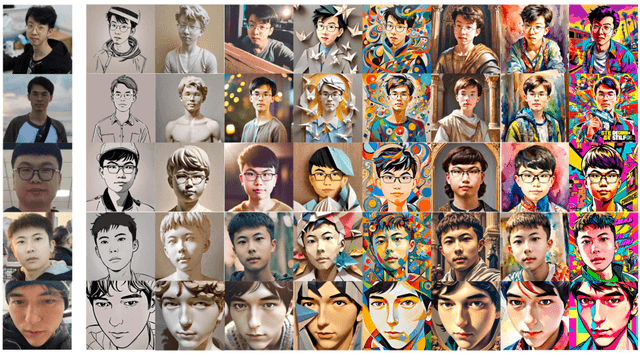
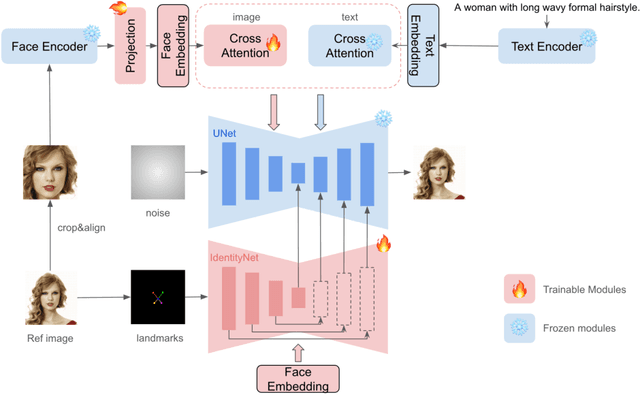
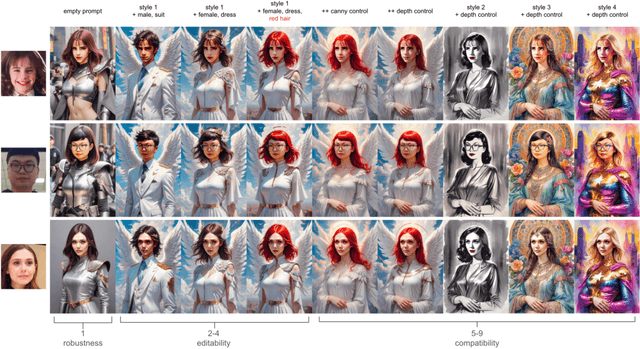
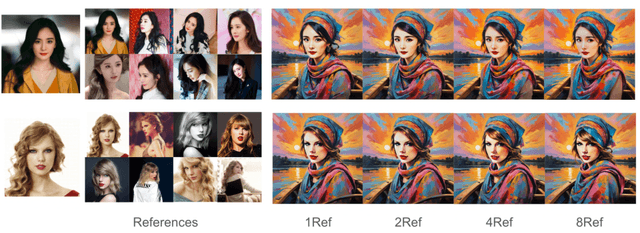
Abstract:There has been significant progress in personalized image synthesis with methods such as Textual Inversion, DreamBooth, and LoRA. Yet, their real-world applicability is hindered by high storage demands, lengthy fine-tuning processes, and the need for multiple reference images. Conversely, existing ID embedding-based methods, while requiring only a single forward inference, face challenges: they either necessitate extensive fine-tuning across numerous model parameters, lack compatibility with community pre-trained models, or fail to maintain high face fidelity. Addressing these limitations, we introduce InstantID, a powerful diffusion model-based solution. Our plug-and-play module adeptly handles image personalization in various styles using just a single facial image, while ensuring high fidelity. To achieve this, we design a novel IdentityNet by imposing strong semantic and weak spatial conditions, integrating facial and landmark images with textual prompts to steer the image generation. InstantID demonstrates exceptional performance and efficiency, proving highly beneficial in real-world applications where identity preservation is paramount. Moreover, our work seamlessly integrates with popular pre-trained text-to-image diffusion models like SD1.5 and SDXL, serving as an adaptable plugin. Our codes and pre-trained checkpoints will be available at https://github.com/InstantID/InstantID.
Split-Ensemble: Efficient OOD-aware Ensemble via Task and Model Splitting
Dec 14, 2023Abstract:Uncertainty estimation is crucial for machine learning models to detect out-of-distribution (OOD) inputs. However, the conventional discriminative deep learning classifiers produce uncalibrated closed-set predictions for OOD data. A more robust classifiers with the uncertainty estimation typically require a potentially unavailable OOD dataset for outlier exposure training, or a considerable amount of additional memory and compute to build ensemble models. In this work, we improve on uncertainty estimation without extra OOD data or additional inference costs using an alternative Split-Ensemble method. Specifically, we propose a novel subtask-splitting ensemble training objective, where a common multiclass classification task is split into several complementary subtasks. Then, each subtask's training data can be considered as OOD to the other subtasks. Diverse submodels can therefore be trained on each subtask with OOD-aware objectives. The subtask-splitting objective enables us to share low-level features across submodels to avoid parameter and computational overheads. In particular, we build a tree-like Split-Ensemble architecture by performing iterative splitting and pruning from a shared backbone model, where each branch serves as a submodel corresponding to a subtask. This leads to improved accuracy and uncertainty estimation across submodels under a fixed ensemble computation budget. Empirical study with ResNet-18 backbone shows Split-Ensemble, without additional computation cost, improves accuracy over a single model by 0.8%, 1.8%, and 25.5% on CIFAR-10, CIFAR-100, and Tiny-ImageNet, respectively. OOD detection for the same backbone and in-distribution datasets surpasses a single model baseline by, correspondingly, 2.2%, 8.1%, and 29.6% mean AUROC. Codes will be publicly available at https://antonioo-c.github.io/projects/split-ensemble
The Data Provenance Initiative: A Large Scale Audit of Dataset Licensing & Attribution in AI
Nov 04, 2023Abstract:The race to train language models on vast, diverse, and inconsistently documented datasets has raised pressing concerns about the legal and ethical risks for practitioners. To remedy these practices threatening data transparency and understanding, we convene a multi-disciplinary effort between legal and machine learning experts to systematically audit and trace 1800+ text datasets. We develop tools and standards to trace the lineage of these datasets, from their source, creators, series of license conditions, properties, and subsequent use. Our landscape analysis highlights the sharp divides in composition and focus of commercially open vs closed datasets, with closed datasets monopolizing important categories: lower resource languages, more creative tasks, richer topic variety, newer and more synthetic training data. This points to a deepening divide in the types of data that are made available under different license conditions, and heightened implications for jurisdictional legal interpretations of copyright and fair use. We also observe frequent miscategorization of licenses on widely used dataset hosting sites, with license omission of 70%+ and error rates of 50%+. This points to a crisis in misattribution and informed use of the most popular datasets driving many recent breakthroughs. As a contribution to ongoing improvements in dataset transparency and responsible use, we release our entire audit, with an interactive UI, the Data Provenance Explorer, which allows practitioners to trace and filter on data provenance for the most popular open source finetuning data collections: www.dataprovenance.org.
PURR: Efficiently Editing Language Model Hallucinations by Denoising Language Model Corruptions
May 24, 2023Abstract:The remarkable capabilities of large language models have been accompanied by a persistent drawback: the generation of false and unsubstantiated claims commonly known as "hallucinations". To combat this issue, recent research has introduced approaches that involve editing and attributing the outputs of language models, particularly through prompt-based editing. However, the inference cost and speed of using large language models for editing currently bottleneck prompt-based methods. These bottlenecks motivate the training of compact editors, which is challenging due to the scarcity of training data for this purpose. To overcome these challenges, we exploit the power of large language models to introduce corruptions (i.e., noise) into text and subsequently fine-tune compact editors to denoise the corruptions by incorporating relevant evidence. Our methodology is entirely unsupervised and provides us with faux hallucinations for training in any domain. Our Petite Unsupervised Research and Revision model, PURR, not only improves attribution over existing editing methods based on fine-tuning and prompting, but also achieves faster execution times by orders of magnitude.
PiMAE: Point Cloud and Image Interactive Masked Autoencoders for 3D Object Detection
Mar 14, 2023



Abstract:Masked Autoencoders learn strong visual representations and achieve state-of-the-art results in several independent modalities, yet very few works have addressed their capabilities in multi-modality settings. In this work, we focus on point cloud and RGB image data, two modalities that are often presented together in the real world, and explore their meaningful interactions. To improve upon the cross-modal synergy in existing works, we propose PiMAE, a self-supervised pre-training framework that promotes 3D and 2D interaction through three aspects. Specifically, we first notice the importance of masking strategies between the two sources and utilize a projection module to complementarily align the mask and visible tokens of the two modalities. Then, we utilize a well-crafted two-branch MAE pipeline with a novel shared decoder to promote cross-modality interaction in the mask tokens. Finally, we design a unique cross-modal reconstruction module to enhance representation learning for both modalities. Through extensive experiments performed on large-scale RGB-D scene understanding benchmarks (SUN RGB-D and ScannetV2), we discover it is nontrivial to interactively learn point-image features, where we greatly improve multiple 3D detectors, 2D detectors, and few-shot classifiers by 2.9%, 6.7%, and 2.4%, respectively. Code is available at https://github.com/BLVLab/PiMAE.
 Add to Chrome
Add to Chrome Add to Firefox
Add to Firefox Add to Edge
Add to Edge